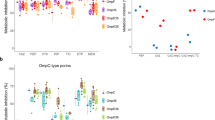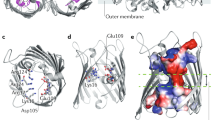Abstract
Antibiotics taken up into gram-negative bacteria face two major diffusion barriers, the outer and cytoplasmic membranes. Of these, the former has been most studied and is discussed in detail here. Evidence from antibiotic MIC studies on porin-deficient mutants compared with their porin-sufficient parent strains has provided strong support for the proposal that some antibiotics, particularlyβ-lactams, pass across the outer membrane through the water-filled channels of a class of proteins called porins. Nevertheless substantial evidence has accumulated for the importance of non-porin pathways of antibiotic uptake across the outer membranes of gram-negative bacteria. Examples discussed include the uptake of polycationic antibiotics via the self-promoted pathway, the uptake of hydrophobic antibiotics in some bacterial species and in mutants of others via the hydrophobic pathway, and the possible importance of poorly understood non-porin pathways of uptake of a variety of antibiotics. Other potential barriers to diffusion, including the cytoplasmic membrane, are briefly discussed.
Similar content being viewed by others
References
Hancock, R. E. W. Aminoglycoside uptake and mode of action — with special reference to streptomycin and gentamicin. Journal of Antimicrobial Chemotherapy 1981, 8: 249–276, 429–445.
Nikaido, H., Vaara, M. Molecular basis of bacterial outer membrane permeability. Microbiological Reviews 1985, 49: 1–32.
Nikaido, H., Hancock, R. E. W. Outer membrane permeability ofPseudomonas aeruginosa. In: Sokatch, J. R. (ed.): The bacteria: a treatise on structure and function, Volume 10. Academic Press, New York, 1985, p. 145–193.
Leive, L. The barrier function of the gram-negative cell envelope. Annals of the New York Academy of Sciences 1974, 235: 109–127.
Hancock, R. E. W. Model membrane studies of porin function. In: Inouye, M. (ed.): Bacterial outer membranes as model systems. John Wiley, New York, 1986, p. 187–225.
Nakae, T. Identification of the major outer membrane protein ofEscherichia coli that produces transmembrane channels in reconstituted vesicle membranes. Biochimica et Biophysica Acta 1976, 71: 877–884.
Zimmermann, W., Rosselet, A. Function of the outer membrane ofEscherichia coli as a permeability barrier toβ-lactam antibiotics. Antimicrobial Agents and Chemotherapy 1977, 12: 368–372.
Nicas, T. I., Hancock, R. E. W. Pseudomonas aeruginosa outer membrane permeability: isolation of a porin protein F-deficient mutant. Journal of Bacteriology 1983, 153: 281–285.
Mitsuyama, J., Hiruma, R., Yamaguchi, A., Sawai, T. Identification of porins in outer membrane ofProteus, Morganella andProvidencia spp. and their role in outer membrane permeation ofβ-lactams. Antimicrobial Agents and Chemotherapy 1987, 31: 379–384.
Harder, K. J., Nikaido, H., Matsuhashi, M. Mutants ofEscherichia coli that are resistant to certainβ-lactam compounds lack the OmpF porin. Antimicrobial Agents and Chemotherapy 1981, 20: 549–552.
Then, R. L., Angehrn, P. Multiply resistant mutants ofEnterobacter cloacae selected byβ-lactam antibiotics. Antimicrobial Agents and Chemotherapy 1986, 30: 684–688.
Woodruff, W. A., Hancock, R. E. W. Construction and characterization ofPseudomonas aeruginosa protein F-deficient mutants after in vitro and in vivo insertion mutagenesis of the cloned gene. Journal of Bacteriology 1988, 170: 2592–2598.
Godfrey, A. J., Bryan, L. E. Penetration ofβ-lactams throughPseudomonas aeruginosa porin channels. Antimicrobial Agents and Chemotherapy 1987, 31: 1216–1221.
Hancock, R. E. W. Role of porins in outer membrane permeability. Journal of Bacteriology 1987, 169: 929–933.
Siden, I., Boman, H. Escherichia coli mutants with altered sensitivity to cecropin D. Journal of Bacteriology 1983, 154: 170–176.
Bedard, J., Wong, S., Bryan, L. E. Accumulation of enoxacin byEscherichia coli andBacillus subtilis. Antimicrobial Agents and Chemotherapy 1987, 31: 1348–1354.
Watanabe, N.-A., Nagasu, T., Katsu, K., Kitoh, K. E-0702, a new cephalosporin, is incorporated intoEscherichia coli cells via thetonB-dependent iron transport system. Antimicrobial Agents and Chemotherapy 1987, 31: 497–504.
Pugsley, A. P., Zimmermann, W., Wehri, W. Highly efficient uptake of a rifampycin derivative via the FhuAtonB-dependent uptake route inEscherichia coli. Journal of General Microbiology 1987, 133: 3505–3511.
Quinn, J. P., Dudek, E. J., DiVincenzo, C. A., Lucks, D. A., Lerner, S. A.: Emergence of resistance to imipenem during therapy forPseudomonas aeruginosa infections. Journal of Infectious Diseases 1986, 289–294.
Hancock, R. E. W. Alterations in outer membrane permeability. Annual Reviews of Microbiology 1984, 38: 237–264.
Rivera, M., Hancock, R. E. W., Sawyer, J. G., Haug, A., McGroarty, G. J. Enhanced binding of polycationic antibiotics to lipopolysaccharide from an aminoglycoside-supersusceptibleto1A mutant strain ofPseudomonas aeruginosa. Antimicrobial Agents and Chemotherapy 1988, 32: 649–655.
Moore, R. A., Hancock, R. E. W. Involvement of outer membrane ofPseudomonas cepacia in aminoglycoside and polymyxin resistance. Antimicrobial Agents and Chemotherapy 1986, 30: 923–926.
Martin, N. L., Beveridge, T. J. Gentamicin interaction withPseudomonas aeruginosa cell envelope. Antimicrobial Agents and Chemotherapy 1986, 29: 1079–1087.
Garrod, L. P., Lambert H. P., O'Grady, F. Antibiotic and chemotherapy. Churchill Livingstone, Edinburgh, 1981.
Angus, B. L., Fyfe, J. A. M., Hancock, R. E. W. Mapping and characterization of two mutations to antibiotic supersusceptibility inPseudomonas aeruginosa. Journal of General Microbiology 1987, 133: 2905–2914.
Hinma, R., Yamaguchi, A., Sawai, T. The effect of lipopolysaccharide on lipid bilayer permeability ofβ-lactam antibiotics. FEBS Letters 1984, 170: 268–272.
Rocque, W. J., Feisk, S. W., Haug, A., McGroarty, E. J. Polycation binding to isolated lipopolysaccharide from antibiotic-hypersusceptible mutant strains ofEscherichia coli. Antimicrobial Agents and Chemotherapy 1988, 32: 308–313.
Bryan, L. E. Bacterial resistance and susceptibility to chemotherapeutic agents. Cambridge University Press, Cambridge, 1982.
Nichols, W. W. On the mechanism of translocation of dihydrostreptomycin across the bacterial cytoplasmic membrane. Biochimica et Biophysica Acta 1987, 895: 11–23.
Chopra, I., Ball, P. Transport of antibiotics into bacteria. Advances in Microbial Physiology 1982, 23: 183–240.
Scherrer, R., Gerhardt, P. Molecular sieving by theBacillus megaterium cell wall and protoplast. Journal of Bacteriology 1971, 107: 718–735.
Slack, M. P. E., Nichols, W. W. Antibiotic penetration through bacterial capsules and exopolysaccharides. Journal of Antimicrobial Chemotherapy 1982, 10: 368–372.
Author information
Authors and Affiliations
Rights and permissions
About this article
Cite this article
Hancock, R.E.W., Bell, A. Antibiotic uptake into gram-negative bacteria. Eur. J. Clin. Microbiol. Infect. Dis. 7, 713–720 (1988). https://doi.org/10.1007/BF01975036
Issue Date:
DOI: https://doi.org/10.1007/BF01975036




